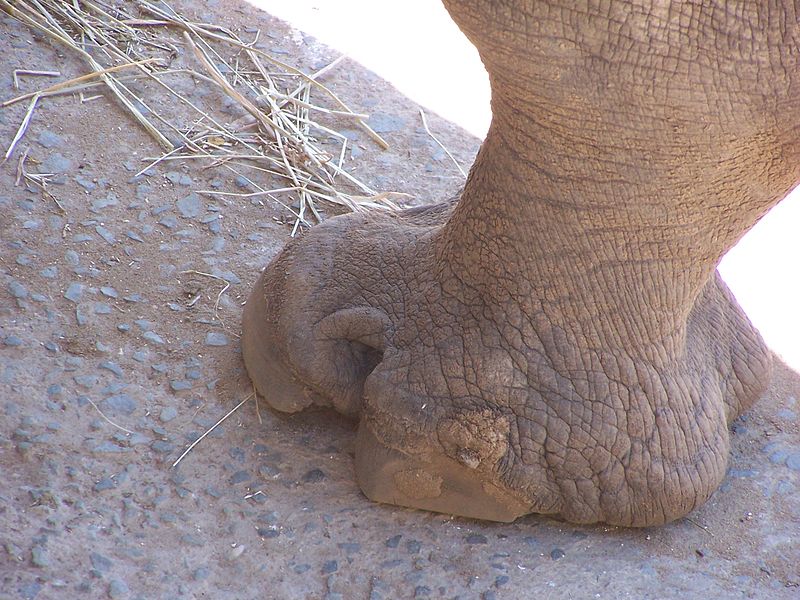Scientists Uncover How Dainty Rhino Feet Support Huge Bodies

How do rhinos' dainty little pigeon-toed feet support their portly bodies?
A group of veterinary scientists in the United Kingdom are on the case. By coaxing three white rhinos to walk back and forth across a "pressure pad," a floor mat embedded with thousands of pressure sensors, the researchers are collecting data on how much force the beasts exert on different parts of their feet as they walk.
A rhinoceros can weigh as much as 8,000 pounds (3,600 kilograms), yet somehow, their feet manage to take all those tons in stride. Initial results show that, with each step, their toes feel peak pressures of 75 pounds per square inch (psi), and the pads of their feet, 15 psi. That's not so much.
"Impressively, the peak pressures aren't that different from human feet (similar range of values), although the timing and distribution of pressures around the feet surely are different to some degree we haven't yet quantified," said John Hutchinson, professor of evolutionary biomechanics at the Royal Veterinary College's structure and motion laboratory and one of the researchers working on the study.
In addition to figuring out how rhino feet manage this feat, the scientists are investigating how the beasts' locomotion differs from that of other large land mammals — in particular, elephants. Unlike elephants, whose columnlike legs turn into feet without much notice, rhinos have relatively thin legs that splay out into larger, circular pads tipped with three rigid toes; they look as if their bodies are teetering on four saplings whose roots are slightly exposed near the ground.
As well as those differences in anatomy, the researchers have learned that the two types of animals carry their weight very differently, too. "Rhinos put more pressure on the inside [edge] of their feet; elephants on the outside, which is weird and we don't really understand it yet," Hutchinson told Life's Little Mysteries, a sister site to LiveScience. [8 Weird Animal Facts]
One technical difficulty of the project has been convincing three rhinos at Colchester Zoo in the U.K. to walk across the researchers' pressure pads, allowing them to collect data. Zookeepers have trained the animals to approach a ball attached to a pole at the other end of the pads by rewarding them with a treat every time they touched their noses to the ball. Still, the beasts easily get distracted from this routine.
Get the world’s most fascinating discoveries delivered straight to your inbox.
"They don't care, really, about science," Hutchinson said in a recent BBC interview.
For that matter, should anyone? What good is this rhino research?
The study of large mammal locomotion may sound like science at its most irrelevant, but it actually has several applications. "Our work is mainly intended to help us detect, monitor and treat abnormal foot pressure patterns in rhinos. Such abnormalities could indicate lameness or deeper health problems, which are a very serious issue with large land mammals like rhinos," he said.
Secondly, learning how rhinos carry their bulk with minimal pressure on their feet could help engineers design heavy load lifters. As Hutchinson explained, "One of our big questions is how do larger animals support loads on their feet, which would help establish principles [for carrying heavier loads], but we still have a ways to go before we can really suggest new inspirations for design."
The scientists plan to publish their results later this year.
Follow Natalie Wolchover on Twitter @nattyover. Follow Life's Little Mysteries on Twitter @llmysteries, then join us on Facebook.
Natalie Wolchover was a staff writer for Live Science from 2010 to 2012 and is currently a senior physics writer and editor for Quanta Magazine. She holds a bachelor's degree in physics from Tufts University and has studied physics at the University of California, Berkeley. Along with the staff of Quanta, Wolchover won the 2022 Pulitzer Prize for explanatory writing for her work on the building of the James Webb Space Telescope. Her work has also appeared in the The Best American Science and Nature Writing and The Best Writing on Mathematics, Nature, The New Yorker and Popular Science. She was the 2016 winner of the Evert Clark/Seth Payne Award, an annual prize for young science journalists, as well as the winner of the 2017 Science Communication Award for the American Institute of Physics.




